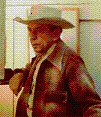
HAROLD "BUCK" WEAVER


TECHNIQUE
Regrettably at the present
time we do not know how many canvases Buck Weaver painted in his lifetime, so
far this website documents all the work which is known to date. It appears, to
date, there has not been any posthumous exhibitions and mention of his name in
printed word is sparse; the excellent biography of Maynard Dixon by Donald J. Hagerty only refers to Buck briefly at two points. From the letters he wrote to
his sister there are long periods when he was not painting due to his heart
condition in later life and nowadays canvases seldom come on to the market.
Numerous newspaper articles refer to Buck as being as near to a disciple to
Maynard Dixon as anyone, upon closer reflection whilst Dixon's oeuvre covers not
only landscapes, but also portraits and both Indian and cowboy scenes, Buck
appears to restrict himself to landscapes. However the sheer grandeur he is able
to achieve with subtle lighting effects and the horizon set low in the painting
is indicative of Dixon's later work.
Whilst Dixon work encompasses all types of media, Oil, Pastel, Gouache and Pen
and Ink, Buck's known oeuvre restricts itself to Oil on canvas. Preparatory
oil sketches appear to feature but none are known to have survived or even been
exhibited. Canvases were painted over a long period and the paint used sparingly
leaving a flat but luminescent surface, for later work, he also designed, made
and gilded frames, not only for his own work but also for Maynard Dixon.
The two works I have had the benefit of closer inspection, one painted at the beginning
of his career (1919) and one at the peak of his career (1947), show he remained careful in dating work and
keeping his trademark signature:
an inverted swastika interlaid with his name
and date, often dotting the middle of the symbol with a complementary colour. The
origins of this symbol are diverse but it does appear within Hopi Indian
culture. It is effectively a symbol of the Hopi emergence into the current
world, showing the directions taken by the various tribes in their wanderings:
the right-hand version signifies "life" or the Sun.

A CLOSER LOOK
On this site two works can be inspected
with the benefit of close-up photography: The Drifter and Pueblo Scene
You will be able to access the close-up areas by scanning the reproduction with your mouse and then clicking.

